Komodo and its Dragons (2/3)
The purpose of our trip was to see the world's largest lizards, a monitor lizard called the Varanus Komodoensis. The locals call them Ora, but they are better known around the world as Komodo Dragons. These lizards can become up to 3 meters long and weigh up to 100kg. They might inspire fear but they are awesome and very impressive.
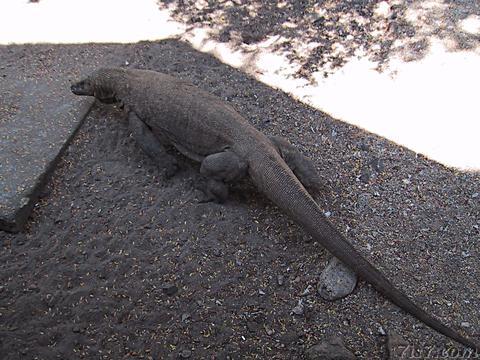
|
| Komodo dragon seen from the restaurant. |
Some dragons just walk through the PHPA camp at Loh Liang. Attracted by the smell of food from the kitchen. So you have a good chance to see some around the restaurant.
They don't seem to be in any hurry, and it looks like you could outrun them easily. This can be quite misleading as they can run at 18km/h.
The best advice is not to get too close. One time I took a picture of a dragon from about 5 meters only to discover as I lowered the camera that there was another one at just 1.5 meters to the left of me!!!
If you have to run away from a dragon, the guides tell us, zigzag, dragons might be able to run fast but turning is not as easy for them as it is for us. Fortunately we didn't have the opportunity to verify this.
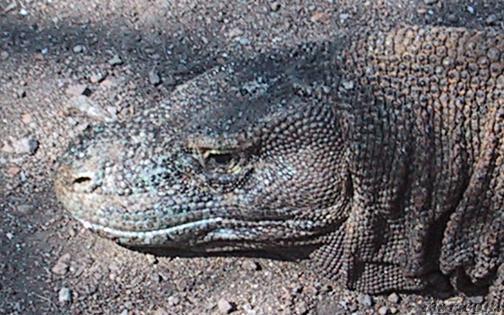
|
| Komodo dragon head. |
Their long tail can be used to whip an enemy or prey, and is said to be quite a blow.
But what's really dangerous is the dragon's mouth.
It is filled with bacteria, which infect a prey once bitten. They track down an injured prey, by following the scent of blood, they wait until it can no longer move or dies from the infections (which can take 2 or 3 days).
Douglas Adams wrote about a Frenchman who was bitten by a Komodo dragon, a long time ago, and who in spite of all the medical care he got still died from the infections several years later back in France.
Being bitten in the leg or arm will probably result in amputation, if you are lucky...
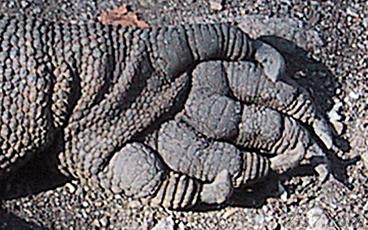
|
| Komodo dragon claw. |
Not only the mouth is deadly, take a closer look at a dragon's front claw, and you can imagine how they tear up their prey.
Below is a picture of a komodo dragon walking towards me, you don't want to hang around too long at such a time. I took a picture and quickly got out of its way. It had just been chased out of a building and wasn't happy at all.
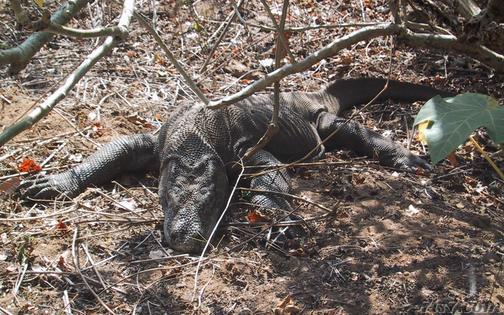
|
| Komodo dragon at Banu Nggulung. |
From the camp we made several guided trips to Banu Nggulung, a dry riverbed where goats were fed to the dragons in the past, in order to entertain visitors. According to the guides this practice made the dragons lazy, since they no longer had to hunt and so it was discontinued.
Douglas Adams wrote a gruesome description of a goat being fed to the dragons, read it and you have a good impression of what is was like in those days.
Today there are still many dragons in and around the riverbed, but they are difficult to spot. You often mistake a tree trunk for a dragon (I guess that's better than the other way round). Some dragons run away as fast as they can on the mere sight, or is it smell, of tourists!
This old female dragon (below), seemed very hungry. According to the guide she was about 35 years old. Dragons can become 50. Apparently she didn't appreciate our presence and started hissing at us. But the guide was not outdone, and we even got to touch her tail.

|
| Young Komodo dragon. |
You're actually less likely to see a female since males outnumber females by 3.4 to 1. Nobody knows why and this remains one of the big mysteries about the dragons.
This young ora (picture on the left) tries to climb a stone wall. Anywhere else you'd consider this to be a big lizard, but on Komodo these ones are small! If you take a closer look you can clearly see the ears, which are actually just holes.
Since komodo dragons eat anything, including their own dead and their young, "baby" dragons spend a lot of time in the trees out of reach of their parents.
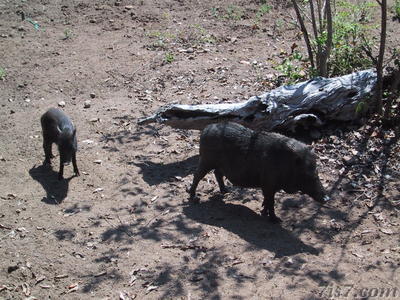
|
| Komodo dragon food. |
Wild pigs and deer roam the island in search of food, many can be seen in and around the camp. They try to keep a safe distance from the dragons, you literally see them walk big circles around a dragon. Although dragons eat wild pigs deer is actually the dragon's favorite food.
Komodo dragons, usually spend the morning warming up in the sun. Later in the day they prefer the shade to stay cool.

|
| Komodo dragon looking at prey. |
Next: Komodo's most famous dragons.



